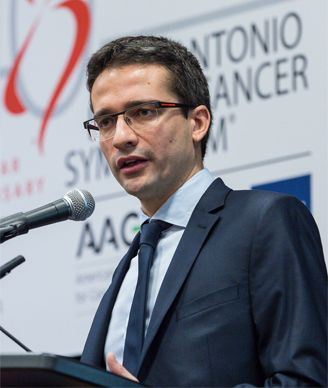Can Temporary Ovarian Suppression During Breast Cancer Treatment Preserve Fertility?
Treatment with gonadotropin-releasing hormone analog can safely and effectively protect ovarian function and has the potential to preserve fertility in premenopausal women undergoing chemotherapy for early-stage breast cancer.
Matteo Lambertini, MD, presenting the results. Photo by © MedMeetingImages/Todd Buchanan 2017

Treatment with gonadotropin-releasing hormone analog (GnRHa) can safely and effectively protect ovarian function and has the potential to preserve fertility in premenopausal women undergoing chemotherapy for early-stage breast cancer, according to the results of meta-analysis presented at the 2017 San Antonio Breast Cancer Symposium (SABCS), held December 5–9.
Fertility and starting a family is often a high priority area of concern for young women with breast cancer, according to Matteo Lambertini, MD, a medical oncologist and European Society for Medical Oncology fellow at the Institut Jules Bordet in Brussels.
“Entering menopause earlier than natural is a common side effect of chemotherapy in premenopausal patients and is associated with substantial negative impact on quality of life,” Lambertini said. “Oocyte and embryo cryopreservation are standard strategies for fertility preservation but they do not prevent the risk of chemotherapy-induced early menopause.”
Temporary ovarian suppression with GnRHa during chemotherapy has been studied, but data are mixed and its role remains controversial. With this systematic review and meta-analysis, Lambertini and colleagues looked at individual patient data from randomized controlled trials that evaluated the efficacy and safety of GnRHa use during chemotherapy.
They identified five trials that included 873 patients; 436 patients received chemotherapy plus GnRHa and 437 received chemotherapy alone. The five clinical trials studied were PROMISE-GIM6, POEMS/SWOG S0230, Anglo Celtic Group OPTION, GBG-37 ZORO, and a Moffitt Cancer Center–led trial. The median age of patients was 38 years.
The rate of premature ovarian insufficiency was 14.1% among patients treated with chemotherapy and GnRHa and more than twice as high in patients assigned to chemotherapy alone (30.9%; odds ratio [OR], 0.38; 95% CI, 0.26–0.57; P < .001).
“This was homogenous across different subgroups and observed regardless of patient’s age at the time of diagnosis, of estrogen receptor status, and type and duration of chemotherapy administered,” Lambertini said.
Although there was no difference in amenorrhea rates at 1 year, the difference at 2 years became significant in favor of combined treatment (18.2% vs 30%; OR, 0.51; 95% CI, 0.31–0.85; P = .009).
About 10% of the patients taking GnRHa plus chemotherapy became pregnant after treatment compared with 5.5% of patients in the control group, suggesting a possible increased rate of future pregnancy in patients who underwent GnRHa. All the pregnancies were observed in patients aged less than 40, Lambertini noted.
At a median of 5 years, there was no observed difference in disease-free survival or overall survival in patients treated with chemotherapy alone or chemotherapy plus GnRHa.
“This strategy should be considered as an option to reduce the likelihood of chemotherapy-induced premature ovarian insufficiency and potentially improve future fertility in premenopausal early breast cancer patients undergoing adjuvant or neoadjuvant therapy,” Lambertini said.
Limitations of the study include the impossibility of including all the randomized clinical trials on this topic, the lack of data on the extent of ovarian function preservation using more sensitive biomarkers, and limited information on patients’ wish to have a pregnancy, according to Lambertini.
Newsletter
Stay up to date on recent advances in the multidisciplinary approach to cancer.





